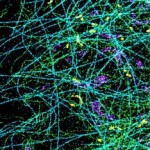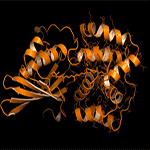Jennifer Doudna, a biochemist in the Lab’s Molecular Biophysics & Integrated Bioimaging Division and the inventor of a revolutionary gene-editing tool, was named one of five laureates of the 2016 L’Oréal-UNESCO for Women in Science Awards in the field of life sciences.
New Catalysts Can be Fine Tuned; Could Replace Precious Metals
Scientists at MIT and Berkeley Lab have developed a new type of catalyst that can be tuned to promote desired chemical reactions, potentially enabling the replacement of expensive and rare metals in fuel cells. Carbon is used as the primary material for electrodes in batteries and fuel cells, and the new catalyst is carbon-based, containing … Read more »
Molecular Imaging Innovation Delivers Spatial, Spectral Info Simultaneously
Using physical chemistry methods to look at biology at the nanoscale, faculty scientist Ke Xu has invented a new technology to image single molecules with unprecedented spectral and spatial resolution, enabling new ways to examine cell structures and study diseases like Alzheimer’s.
Orange is the New Red
Cheryl Kerfeld of the Molecular Biophysics & Integrated Bioimaging (MBIB) Division led the discovery that a photo-protective mechanism in cyanobacteria is triggered by an unprecedented, large-scale movement from one location to another of the carotenoid pigment within the Orange Carotenoid Protein.
Instrumentation Advances Expand the Reach of X-ray Free Electron Lasers
Femtosecond crystallography (FX) is especially suitable for studying radiation sensitive enzymes that require metals for their function, as the extremely short and bright X-ray pulses can produce a diffraction image before any atomic motions can occur in the crystal. This cutting edge method is capable of extending our capacity to study smaller, more fragile crystals and determine the catalytic structures of biologically relevant macromolecules.
Was this page useful?








